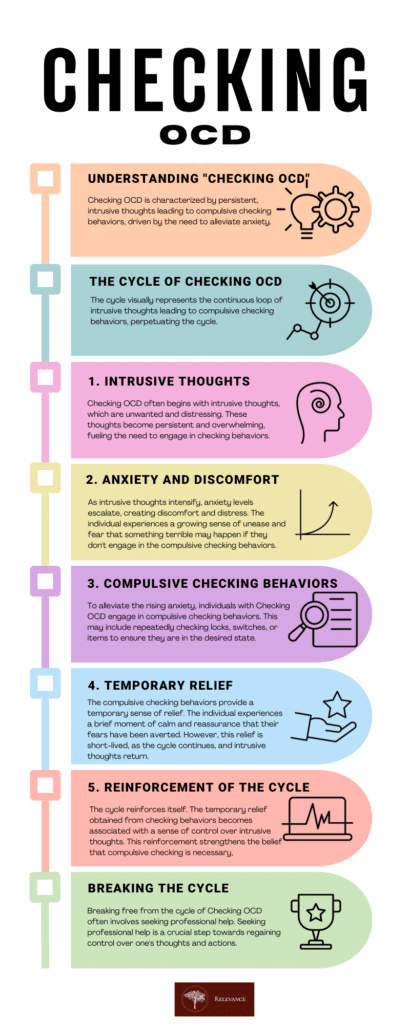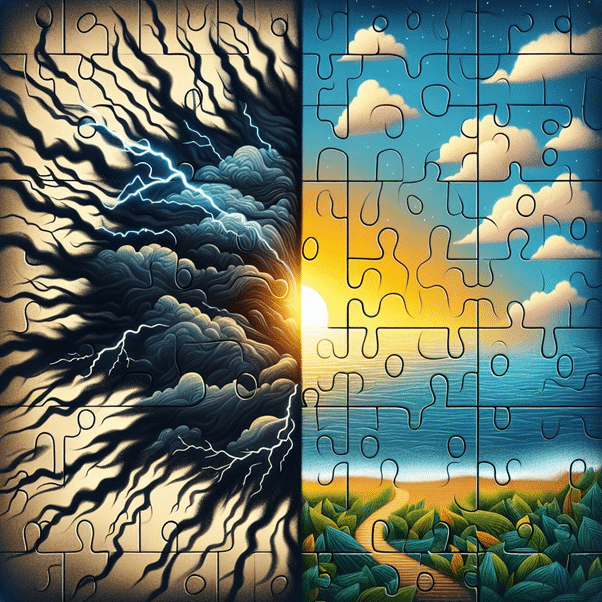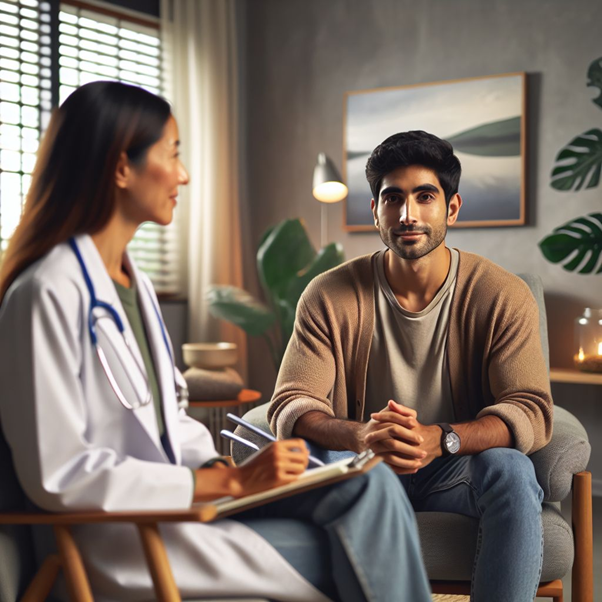Have you ever wondered why Obsessive-Compulsive Disorder (OCD) is so challenging to diagnose? Imagine being caught in a web of recurring thoughts and behaviors, yet every expert you visit suggests a different condition. This is the complex world of OCD differential diagnosis characterized by persistent, intrusive thoughts (obsessions) and repetitive behaviors or mental acts (compulsions), and there is no one-size-fits-all approach to diagnosis. While OCD is a well-known term, understanding its various subtypes and accurately diagnosing them is crucial for effective treatment.
There are a number of common OCD symptoms and behaviors that can help clinicians differentiate OCD from other mental health conditions.
This comprehensive guide delves into the intricacies of OCD differential diagnosis, focusing on specific subtypes such as Harm OCD, Checking OCD, and Mental Compulsions.
Key Steps in Differentiating OCD: A Clinician’s Guide
Differential diagnosis is the process of distinguishing one disorder from others that may share similar symptoms. In the case of OCD, several subtypes present unique challenges in diagnosis, as their symptoms can overlap with other mental health conditions. To achieve an accurate diagnosis, it’s crucial to delve into specific manifestations of OCD and differentiate them from other disorders. In order to diagnose OCD, clinicians will typically consider the following factors:
- The nature of the obsessions and compulsions: OCD obsessions are typically intrusive and unwanted thoughts that cause significant anxiety or distress. OCD compulsions are repetitive behaviors or mental acts that people feel driven to perform in order to reduce anxiety or prevent a feared outcome.
- The severity of the obsessions and compulsions: OCD obsessions and compulsions can be severe enough to cause significant impairment in a person’s life.
- The duration of the obsessions and compulsions: OCD obsessions and compulsions must be present for at least two weeks in order for a diagnosis to be made.
- The presence of other mental health conditions: OCD can co-occur with other mental health conditions, such as anxiety disorders, depression, and substance use disorders.
Understanding Harm OCD Symptoms: More Than Just Fear
Harm OCD is a subtype of obsessive-compulsive disorder (OCD) characterized by intrusive thoughts about causing harm to oneself or others. These thoughts can be extremely distressing and can lead to significant anxiety and impairment.
Harm OCD obsessions can take many different forms, but some common examples include:
- Fear of harming oneself or others intentionally
- Fear of losing control and harming oneself or others unintentionally
- Fear of being responsible for harm that happens to others
- Fear of having harmful thoughts or urges
Harm OCD compulsions are repetitive behaviors or mental acts that people perform in an attempt to reduce anxiety or prevent the feared outcome. Some common examples of harmful OCD compulsions include:
- Avoiding situations or people that may trigger harmful thoughts
- Reassuring oneself that one will not harm oneself or others
- Checking to make sure that one has not harmed oneself or others
- Engaging in mental rituals, such as praying or counting
Despite the intense fear that harmful OCD thoughts provoke, people with harmful OCD are not at an increased risk of acting on these thoughts. In fact, most people with self-harm OCD find their thoughts to be abhorrent and repugnant.
The challenge in harm OCD differential diagnosis lies in distinguishing it from other conditions like generalized anxiety disorder (GAD), panic disorder, or even psychotic disorders. However, there are some key differences that can help clinicians to make a diagnosis.
For example, people with GAD typically experience excessive worry about a variety of potential threats, while people with harm OCD focus specifically on the fear of harming themselves or others. People with panic disorder typically experience sudden and unexpected attacks of intense fear, while people with harm OCD experience more persistent and intrusive thoughts. People with psychotic disorders typically experience delusions or hallucinations, while people with harm OCD do not.
If you are experiencing harmful OCD symptoms, it is important to seek professional help. A therapist can help you to understand your condition, develop coping mechanisms, and manage your symptoms.
Case Study: John’s Struggle with Harm OCD
John, a 28-year-old software developer, began experiencing distressing thoughts about harming his loved ones. Despite being a gentle person with no history of violence, he found himself plagued by intrusive images of unintentionally causing harm to his family. These thoughts were so vivid and disturbing that John started avoiding kitchen knives and other sharp objects, fearing he might lose control and act on these impulses.
His anxiety escalated to the point where he would repeatedly check if the doors were locked and appliances turned off, worried that any oversight might lead to a disaster. John’s condition not only affected his mental health but also strained his relationships and work performance, as he spent hours stuck in these checking rituals.
Feeling isolated and confused, John sought help from a therapist specializing in OCD. Through Cognitive Behavioral Therapy (CBT) and Exposure Response Prevention (ERP), he gradually learned to confront and manage these fears. His therapist helped him understand that these obsessions were symptoms of Harm OCD, not reflections of his true character.
John’s journey to recovery highlighted the importance of understanding OCD subtypes for effective treatment. His experience serves as a beacon of hope for others facing similar struggles, demonstrating that with the right help, managing OCD is possible.
For a deeper understanding of OCD treatment strategies, see our detailed guide here.
Checking OCD: Understanding the Possibility of Spontaneous Improvement
Checking OCD stands as a distinctive subset within the spectrum of obsessive-compulsive disorder (OCD), characterized by repetitive checking behaviors that stem from an overwhelming fear of impending calamity should a specific action be neglected.
For instance, individuals with checking OCD may find themselves repeatedly verifying that locks are secured, or that appliances and faucets are turned off, driven by an internal compulsion to avert potential disasters.
The repercussions of Checking OCD extend beyond mere habituation; it becomes a debilitating condition consuming considerable time and energy in the incessant repetition of checking rituals. Such behaviors not only compromise daily functionality but also cast a shadow on a person’s overall well-being.
Examples of checking OCD behaviors include:
- Verifying locked doors
- Confirming switched-off appliances
- Ensuring faucets are turned off
- Validating medication intake and task completion
- Reviewing emails or documents for errors
- Redoing tasks to attain perceived perfection
While the semblance of routine might initially cloud the distinction between checking OCD and habitual behaviors, a critical disparity emerges. Individuals with checking OCD are propelled by an undercurrent of anxiety and an inherent compulsion to perform these checks, believing that neglect may lead to dire consequences, such as burglary, fire, or a medical emergency.
Clinical diagnosis of checking OCD involves careful consideration of the following factors:
- The repetitive and anxiety-driven nature of checking behaviors.
- The extent of distress or impairment caused by these behaviors in daily life.
- The duration of checking behaviors persists for a minimum of two weeks.
- The potential co-occurrence of checking OCD with other mental health conditions like anxiety disorders, depression, or substance use disorders.
Recognizing the significance of seeking professional help, individuals experiencing checking OCD symptoms are encouraged to consult with a therapist. Professional guidance can aid in understanding the condition, developing effective coping mechanisms, and managing the symptoms associated with this subtype of OCD.
Distinguishing Checking OCD Amidst Habits and Routines

Discerning between checking OCD and routine habits can pose a challenge, but key distinctions can illuminate the path.
Individuals with checking OCD often feel compelled to perform checks, driven by irrational fears, and may experience significant anxiety if unable to complete the ritual. Conversely, habits and routines are typically automatic, devoid of compulsive urges, and do not evoke substantial anxiety if left unfulfilled.
For those uncertain about whether their checking behaviors align with checking OCD, seeking the expertise of a mental health professional becomes paramount. A thoughtful assessment by a professional can lead to a clearer understanding of symptoms and an accurate diagnosis, paving the way for effective intervention and support.
For a deeper understanding of OCD treatment strategies, see our detailed guide here.
OCD Mental Compulsions
Mental compulsions refer to repetitive, internal mental acts that individuals with OCD engage in to alleviate anxiety or prevent a feared event. Unlike external behaviors, these compulsions take place within the mind, making them less noticeable to others but equally distressing for the individual.
Examples of Mental Compulsions:
- Counting or Repeating: Individuals may mentally count to a certain number or repeat specific words or phrases as a way to neutralize obsessive thoughts.
- Praying or Seeking Reassurance: Some individuals may engage in compulsive praying or seek reassurance from others, hoping to alleviate the anxiety associated with their obsessive fears.
- Mental Reviewing: Constantly reviewing past events or conversations to ensure that no harm occurred or that a mistake wasn’t made.
- Compulsive Analysis: Analyzing situations excessively in an attempt to predict or prevent negative outcomes, even when the feared events are highly unlikely.
Here are some suggestions for effectively handling OCD mental compulsions:
- Identify your compulsions: The initial step in managing OCD mental compulsions is recognizing them. Understanding what these compulsions are empowers you to develop strategies for addressing them.
- Challenge your thoughts: OCD thoughts often intrude irrationally. It’s crucial to challenge these thoughts to diminish their influence. By questioning their validity, you can reduce their power over your mindset.
- Expose yourself to your fears: Confronting the things that trigger your fears is a powerful way to manage OCD mental compulsions. This exposure allows you to recognize that your fears are not grounded in reality and that you possess the capability to cope with them.
- Seek professional help: If managing OCD mental compulsions becomes challenging on your own, seeking professional help is vital. A therapist can provide valuable guidance, teach coping skills, and assist in developing a tailored treatment plan.
- Remember, you are not alone: OCD is a prevalent mental health condition, and successful treatment is attainable. Acknowledging that you are not alone in facing these challenges can be a source of comfort and encouragement as you work towards managing and overcoming OCD.
For a deeper understanding of OCD treatment strategies, see our detailed guide here.
The Final Say:
Understanding OCD is the first step towards effective management. If you or someone you know shows these symptoms, reaching out for professional help can be a life-changing decision. Let’s demystify OCD together and support those who battle it daily. This guide talked about Harm OCD, Checking OCD, and the not-so-obvious mental compulsions. It’s not easy to tell OCD apart from other mental issues, so getting help from professionals is super important.
To wrap it up, getting the right diagnosis helps create the best plan to deal with OCD. Whether it’s dealing with scary thoughts, repeated actions, or things happening in your mind, talking to someone who knows about this stuff is the first important step.
Let’s all work together to learn more about OCD, break down the stigma, and make sure people with OCD get the support and understanding they need.
Have you or someone you know experienced challenges in diagnosing OCD? Share your story in the comments.









